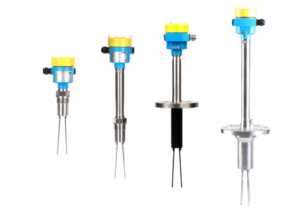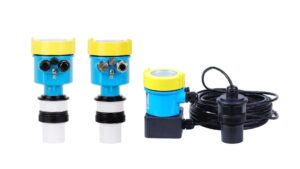Level switches and level transmitters (level meters) are widely used industrial instruments for monitoring and controlling the height or position of materials, but their functions and applications vary significantly. Understanding these differences is essential to choosing the right device for specific industrial needs.
1. Level Switch
- Function: A level switch is a point-level detection device designed to send a signal or trigger an action (e.g., start/stop material flow, alarm) when the material reaches a predefined point. It does not provide continuous level readings; instead, it only operates when the material level reaches a specific threshold.
- How It Works: The switch remains inactive until the material level either rises or drops to a particular preset point. Upon reaching this level, the device signals an action (e.g., shutting off a pump or conveyor belt, sounding an alarm).
- Applications:
- On/Off Control: Level switches are ideal for simple control tasks where precise measurement is unnecessary. For example, they can activate an alarm when a tank is full or stop a conveyor belt when the material reaches a set limit.
- Limit Detection: These switches are often used in bins, hoppers, and tanks to detect high and low levels of solids, liquids, or powders.
- Industry Use: Commonly applied in sectors such as cement, grain storage, oil, and water treatment, where point-level control is adequate for safe and efficient operations.
Types of Level Switches:
- Float Switches: Detect levels based on the buoyancy of a float. When the float rises or falls with the material, it triggers a switch.
- Capacitive Switches: Use changes in capacitance caused by the presence of material to send a signal.
- Vibrating Fork Switches: Vibrate at a certain frequency and detect level by the change in frequency when material covers the sensor.
2. Level Transmitter (Level Meter)
- Function: A level transmitter, also known as a level meter, is a continuous measurement device that provides real-time, ongoing data about the material’s height. Unlike level switches, it offers a precise measurement of material height, making it suitable for applications that require accurate monitoring and control.
- How It Works: The transmitter continuously measures the material level and sends a signal proportional to the height or volume of material present. This data is typically transmitted to a control system, allowing for precise regulation of material handling processes.
- Applications:
- Continuous Monitoring: Level transmitters are essential when continuous, real-time data is needed. They provide the operator with precise information about material levels, which is vital for processes that require ongoing regulation of material flow or storage.
- High-Precision Processes: These devices are used in industries where accurate level measurement is critical, such as in chemical processing, oil and gas refining, food and beverage production, and pharmaceuticals.
- Industrial Use: Common in storage tanks, process vessels, silos, and reactors, where operators need to maintain specific levels of liquids, powders, or slurries.
Types of Level Transmitters:
- Ultrasonic Level Transmitters: Use sound waves to measure the distance from the sensor to the material surface.
- Radar Level Transmitters: Send radar signals and measure the time taken for the signal to reflect back from the material surface to determine the level.
- Hydrostatic Level Transmitters: Measure the pressure exerted by the fluid at a particular depth to calculate the level of liquid in a tank.
Key Differences Between Level Switches and Level Transmitters
| Feature | Level Switch | Level Transmitter |
|---|---|---|
| Measurement Type | Point-level detection; activates at a preset point | Continuous-level measurement, real-time data |
| Output Signal | On/Off signal (binary signal) | Analog or digital signal (proportional) |
| Precision | Detects whether a material has reached a specific point, not the exact level | Provides precise material height/volume data |
| Best Use Case | Simple high/low level detection, limit control | Detailed, continuous monitoring of material levels |
| Applications | Silo, bin level detection, overfill/underfill protection | Industrial tanks, reactors, process vessels |
Choosing Between a Level Switch and a Level Transmitter
When deciding whether to use a level switch or a level transmitter, it’s important to consider the requirements of the specific application.
- Choose a Level Switch if:
- You only need to know whether the material has reached a particular high or low point.
- Precision is not critical; the application only requires detection of an upper or lower limit.
- You want a simple and cost-effective solution for limit detection.
- Common in applications like overflow prevention, low-level alerts, and safety cutoffs.
- Choose a Level Transmitter if:
- You require real-time, accurate level data for continuous monitoring and control.
- The process involves critical levels of liquids or solids, and precise measurement is necessary.
- You need to integrate the system into a larger control network, where data needs to be fed into automated systems for process regulation.
- Common in applications like inventory management, process optimization, and regulatory compliance.
Conclusion
Both level switches and level transmitters play vital roles in material level monitoring across various industries, but they cater to different needs. Level switches are cost-effective solutions for simple point-level detection, while level transmitters provide the continuous, precise data necessary for detailed process control. Understanding the distinction between the two will help in selecting the appropriate instrument for the specific industrial application, ensuring both efficiency and safety in material handling.



